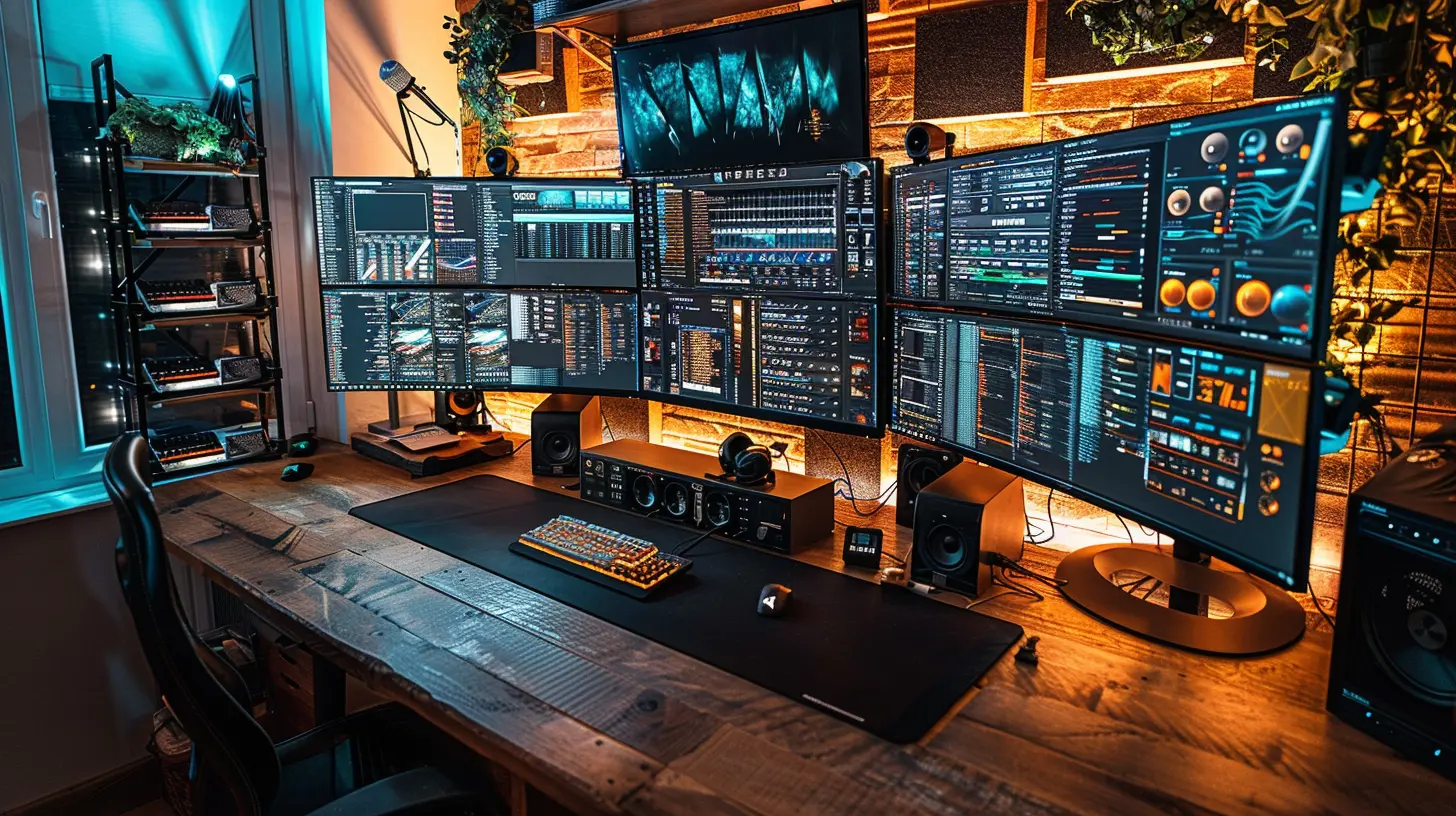The Rise of Ultra-Wide Monitors: Is it Worth the Investment?
17 October 2025
If you’ve spent any time shopping for computer monitors lately, you’ve probably noticed a trend that’s hard to ignore – ultra-wide monitors are taking over. These massive, panoramic displays seem to be everywhere, dominating tech blogs, gaming setups, and even business environments.
But before you drop a hefty chunk of change on one, you’re probably wondering: Is it really worth the investment? Are they just a flashy trend or do they provide real value for everyday use? Let’s dive in and break it all down.

What Exactly is an Ultra-Wide Monitor?
First things first: what are we even talking about when we say "ultra-wide monitor"?An ultra-wide monitor is a display that typically has an aspect ratio of 21:9 or higher. To put that into perspective, most standard monitors have an aspect ratio of 16:9, which is the typical ratio for TVs and standard computer screens. So, ultra-wide monitors are noticeably wider, offering a much broader field of view.
Some of these screens are flat, while others are curved, wrapping around your vision for a more immersive experience. They can range in resolution from the basic 1080p to the crisp 4K (or even higher). So, yeah, they’re pretty impressive at first glance – but let’s dig a little deeper.

The Appeal of Ultra-Wide Monitors
1. Multitasking Like a Pro
One of the most obvious reasons people flock to ultra-wide monitors is their insane multitasking capabilities. If you’re someone who constantly juggles multiple apps, windows, or programs, this is where ultra-wide monitors really shine.Instead of being confined to the standard split-screen, you can have three or even four windows open side-by-side without feeling cramped. Think about how much smoother your workflow could be if you didn’t have to constantly alt-tab between windows or minimize and expand different applications.
It’s basically like having two (or even three) monitors in one sleek package. And let’s be honest, who doesn’t want to feel like a productivity powerhouse?
2. A Gamer’s Dream
For gamers, ultra-wide monitors are a game-changer (pun intended). The immersive experience that comes with a wider field of view can transport you right into the action. Many modern games are optimized for 21:9 aspect ratios, allowing you to see more of the game world at once. Whether you're deep into a first-person shooter or exploring a vast open-world RPG, the extra screen real estate can give you a competitive edge.And those curved monitors? They take it to the next level, wrapping the action around your field of vision for an almost VR-like experience without the clunky headset.
3. Cinematic Bliss
Let’s not forget about entertainment. If you love watching movies or binge-watching your favorite shows, an ultra-wide monitor can give you that perfect cinematic experience. Most movies are shot in a 21:9 aspect ratio, which means no more annoying black bars on the top and bottom of the screen. Just pure, edge-to-edge viewing pleasure.For anyone who’s serious about their Netflix time, this is the kind of upgrade that’s hard to pass up.
4. A Clean, Minimalist Setup
For those who crave a clean, minimalist workspace, ultra-wide monitors are a dream come true. Instead of having multiple monitors with tangled cables and awkward stands, you’ve got one sleek display. It’s a much more streamlined look that doesn’t clutter your desk.Not to mention, you don’t have to deal with annoying bezels in between two monitors. Everything is seamless, and let’s face it – it looks much cooler.

The Downsides You Should Consider
Now, before you sprint to the store and throw your money at the shiniest ultra-wide monitor you can find, let’s talk about the possible downsides. Because, as with anything, there are a few things you should think about before making the leap.1. Price Tag: A Hefty Investment
There’s no sugar-coating this one – ultra-wide monitors can be expensive. We’re not talking about the price of a budget 24-inch monitor here. Depending on the size, resolution, and features, you could be looking at anywhere from a few hundred dollars to well over a thousand.So, if you’re on a tight budget, this might not be the most practical purchase. But then again, if you’re serious about your gaming, productivity, or entertainment experience, you might consider it an investment rather than just an expense.
2. Not All Software Plays Nicely
While many programs are starting to support ultra-wide resolutions, there are still some that don’t. This can lead to stretched-out images or black bars on the sides of your screen, which kind of defeats the purpose of having all that extra space.Some older games, for example, may not support 21:9, leaving you with a less-than-ideal gaming experience. And certain business software may not scale properly, causing layout issues. So, depending on what you’re using your monitor for, you might run into some hiccups.
3. Desk Space: Do You Have Enough?
Ultra-wide monitors are, well, wide. It may seem obvious, but make sure you have enough space on your desk to accommodate one. These are not small screens, and they can easily eat up a good chunk of your workspace. If you’re already tight on space, this could be a real issue.Also, if you opt for a curved model, you’ll need even more room, as the curvature can make the monitor take up more physical space than a flat one. So, before you hit “buy,” double-check your desk dimensions.
4. Potential For Eye Strain
This one’s a bit subjective, but it’s worth mentioning. While some people love the immersive experience of an ultra-wide monitor, others find it overwhelming or even slightly disorienting, especially with curved models.If you’re sitting close to your screen or working long hours, the extra width might cause more eye strain than you’re used to. It’s not a dealbreaker for everyone, but it’s something to keep in mind, especially if you’re sensitive to bright or expansive screens.

Is It Worth the Investment?
Okay, so here’s the million-dollar question: is an ultra-wide monitor worth it?The answer really depends on what you’re going to use it for.
If you’re someone who does a lot of multitasking, works in creative fields like video editing or design, or you’re a hardcore gamer, then the benefits of an ultra-wide monitor could absolutely be worth the money. The extra screen real estate can boost your productivity, make your gaming more immersive, and give you a cinematic experience that’s hard to replicate on a standard monitor.
On the other hand, if you’re someone who primarily uses their computer for simple tasks like browsing the web, checking emails, or watching the occasional YouTube video, an ultra-wide monitor might be overkill. You could probably get by just fine with a standard 16:9 monitor and save yourself some cash.
So, while the thought of having a massive, ultra-wide screen might be appealing (and let’s be honest, it looks super cool), consider your actual needs and how much you’re willing to spend.
What to Look for If You Decide to Buy One
If you’ve made it this far and you’re seriously considering an ultra-wide monitor, here are a few things to look out for:- Resolution: Higher resolution means sharper images. Aim for at least 1440p, but if you can swing it, 4K is even better.
- Refresh Rate: If you’re a gamer, a higher refresh rate (like 120Hz or 144Hz) is key for smooth gameplay.
- Curved vs. Flat: Curved monitors offer more immersion, but they’re also more expensive and take up more space. Choose based on your personal preference and setup.
- Ports and Connectivity: Make sure the monitor has the right ports for your devices (HDMI, DisplayPort, USB-C, etc.).
- Adjustability: Ideally, look for a monitor with height, tilt, and swivel adjustments so you can find the most comfortable viewing position.
Final Thoughts
At the end of the day, ultra-wide monitors are a fantastic piece of tech that can significantly enhance your work, gaming, and entertainment experiences. They bring a “wow” factor that’s hard to deny, and for the right person, they’re absolutely worth the investment.But like any tech purchase, they’re not for everyone. If you don’t need all that extra space or you’re operating on a tight budget, it might not make sense for you to splurge on an ultra-wide monitor.
But if you’re ready to level up your workspace or gaming setup, an ultra-wide monitor could be just the thing to take it to the next level.
all images in this post were generated using AI tools
Category:
Computer PeripheralsAuthor:

Ugo Coleman
Discussion
rate this article
1 comments
Callista Williams
Great read! Ultra-wide monitors truly transform the workspace, offering expansive views that enhance productivity and immersion in gaming. The investment can significantly boost efficiency and comfort, making multitasking a breeze. Excited to see how this trend evolves—definitely worth considering for anyone looking to upgrade their setup!
October 17, 2025 at 4:20 AM

Ugo Coleman
Thank you! I'm glad you found the article valuable. Ultra-wide monitors truly do enhance productivity and immersion—an exciting trend indeed!


